Happy Lao New Year! May you and yours enjoy a safe and prosperous 2553! Confused? I was too. It turns out that my arrival in Luang Prabang (“Loo ONG Prah BONG”), a place I’ve been looking forward to for about a year, coincided exactly with the busiest part of Lao New Year, called Pi Mai (or Pimai, or Pii Mai or Pee Mai… and pronounced “Pee My”). I did not plan it this way, but when I look back on earlier posts about Laos, I realize that I did know that New Year was celebrated in April, but that knowledge must have slipped out of my mind long, long ago. (Aside – my TTNY blog for Laos was posted on April 14, 2009. And my first full day in Luang Prabang? April 14, 2010. How’s that for some pretty slick planning/traveling?)
I’ve been a bit whiny about how places like Hanoi and Vientiane haven’t quite lived up to their write-ups in the LP, so I’m happy to report that Luang Prabang is actually all it’s cracked up to be. Quiet, leafy streets, charming architecture, Buddhist monasteries (called “wats”) everywhere you turn, and orange-robed monks all over the place. It’s no wonder UNESCO declared the whole town a World Heritage site.
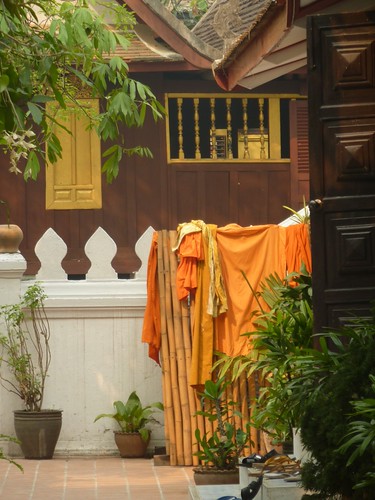 For some reason I find monks’ laundry very picturesque
For some reason I find monks’ laundry very picturesque
Unlike western New Year’s celebrations, Pi Mai goes on for days. Technically the holiday lasts three days, but in popular spots like Luang Prabang the festivities can stretch to a week or so.
“The first day, known as Maha Songkran, is considered the last day of the old year. Lao will clean their houses and villages on this day, and prepare water, perfume, and flowers for the days ahead. The second day, the "day of no day", is neither part of the old year nor of the new year. The third day, known as Wan Thaloeng Sok is the official start of the Lao New Year.” (from goseasia.com)
I spent my first afternoon in Luang Prabang just wandering around the streets of the oldest part of town, but before I went out, I had to do a bit of preparation. I wrapped everything important in individual ziploc bags – wallet, books, iPhone, camera – because one of the main ways that Pi Mai is celebrated is by throwing water on people passing by in the street. The later it gets in the day, the more gangs you see on the sidewalk with hoses, big pans of water, pitchers, scoops, buckets and water pistols. When you walk by you get doused, and there’s really nothing you can do to stop it.
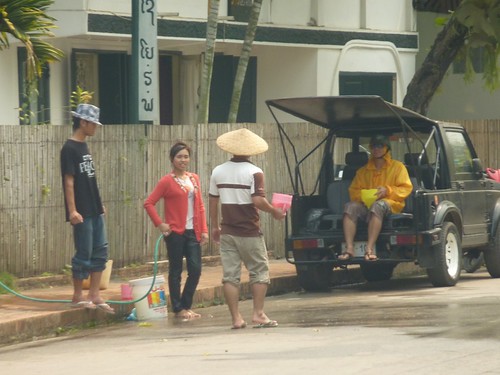 This is a small group, on a side street, early in the Festival
This is a small group, on a side street, early in the Festival
It was kind of fun, but could also get a bit tiresome. In the right frame of mind it’s a huge party, and a lot of the people on the main street are clearly backpacker types who’ve come here mostly for the water fight. They invest in a super-soaker water gun and a lot of Beerlao, and have a great time. I’m not really in that category so sometimes, especially when I was hot and tired and had just had to wrap or unwrap my wallet or phone or camera or map for the 947th time I just wanted to shout, “Would you all just please go home so I can see this town properly?!” Then again there were the times when it was so hot and humid that it was really refreshing to get hosed down, and the party atmosphere was infectious.
 Here’s what it looked like late in the afternoon on Day Two. Total, drippy, drunken chaos. So much water was used on Day One that when I got back to my hotel late in the evening I was told I couldn’t have a shower because there was no water left in the whole town.
Here’s what it looked like late in the afternoon on Day Two. Total, drippy, drunken chaos. So much water was used on Day One that when I got back to my hotel late in the evening I was told I couldn’t have a shower because there was no water left in the whole town.
On the first day of Pi Mai I got out of chaos for the afternoon on a short day trip I’ll tell you about in another post. When I got back I took a little riverboat canoe across the Mekong with Rob and Linda, a couple of friends I’d met on my day trip, to check out another local Pi Mai tradition. On a sandy spit of land that juts into the Mekong river the local people had set up a huge beach party and spent the afternoon making sand stupas along the shore. (Quick reminder: a "stupa” is a mound-like structure, normally very big, containing Buddhist relics). We were expecting these sand stupas to be huge, but it turned out they were just like sandcastles at home – about two or three feet across for the most part. They were decorated with flour and painted banners, and there were hundreds of them.
By the time we got there, though, the stupas were mostly forgotten and people were busily engaged in eating, drinking lots and lots of Beerlao, listening to loud music and dancing. Rob’s trenchant observation was that teenagers are the same everywhere – they just want to hang out with friends, listen to loud music and get drunk. We could have been anywhere in the world, except for the fact that most of the people were still drenched and many were covered in flour. (The later it gets in the festival, the crazier it gets. By Day Two it’s not just water getting thrown around, there are also people walking around with bags of flour who merrily fling handfuls of the stuff on you. And then there are the gangs of people who put coloured dye in the water. The gutters were running bright green at one point, I swear.)
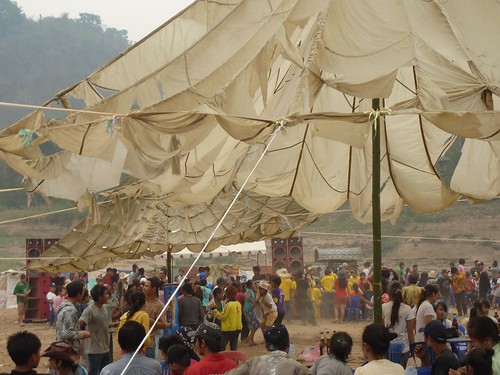 A small part of the party on the beach, under a couple of decidedly down-at-heel parachute canopies
A small part of the party on the beach, under a couple of decidedly down-at-heel parachute canopies
On Day Two of Pi Mai, “the day of no day”, I did not leave town. How could I? I had to stick around for the big parade! At 1:00 pm (or thereabouts, this is Laos afterall) there was going to be a parade down the main street in town. The woman who had been crowned Miss Laos a few days earlier would proceed from the south end of town to the oldest temple in Luang Prabang, Wat Xieng Thong, at the tip of the peninsula formed by the fork between the Mekong and Nam Khan Rivers (and conveniently close to my guest house). Of course she would be accompanied by loads of other people, including lots of monks and local people in traditional dress and people banging on drums and wearing masks and such.
And even though it was a parade it seemed that everyone was fair game when it came to the water fight. I’ve read that it’s considered respectful to gently pour water onto your elders and monks, but you’re free to douse anyone else with impunity. This rule seemed to be applied somewhat haphazardly, though I did notice that the monks in the parade got fairly respectful treatment, at least until they got into the real war zone areas of the street where no one was safe (or dry).
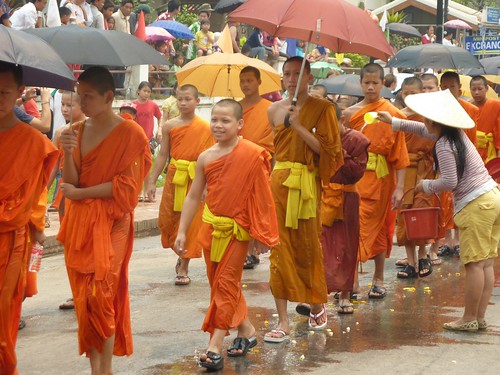 Some of the parade of monks, one being watered down quite calmly by a local woman.
Some of the parade of monks, one being watered down quite calmly by a local woman.
Eventually Miss Lao passed by, reclining on a large papier maché horse. She was facing the other way, though, so I didn’t really get any good photos. Once the parade was over I was hot and tired and sweaty, so I walked straight down the middle of the craziest part of the street. It didn’t take long before I was drenched to the skin, mostly thanks to a guy wielding a pressurized hose, who was clearly upping the ante on the whole water fight business. If this kind of escalation keeps up we can expect to see fire hoses and water bombers in Luang Prabang for Pi Mai 2554.
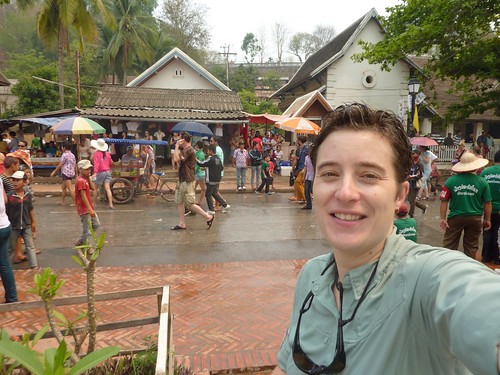 Me, wet, refreshed, and in the swing of things for Pi Mai
Me, wet, refreshed, and in the swing of things for Pi Mai
On Day Three of the festivities there was, you guessed it, another parade! Naturally they could not leave Miss Laos stranded up at the Wat Xieng Thong, so on the day after the south-to-north parade everyone saddled up again for the trip north to south. I decided to skip the second parade because by that time I was suffering from a bit of Pi Mai fatigue and starting to grow moss between my toes from being wet all the time.
There was another Pi Mai tradition that caught my attention – I noticed women wandering around with bundles of tiny wicker cages. Inside each cage was a pair of live birds! It turns out that the birds are for sale, the intention being that you gain spiritual merit by releasing them from their captivity. (Nevermind that it would seem that greater spiritual merit might come from not imprisoning the birds in the first place…). On my first morning while I was having breakfast, I got approached by one of these vendors, so I went ahead and paid my 20,000 Kip ($2.40) for a pair of birds.
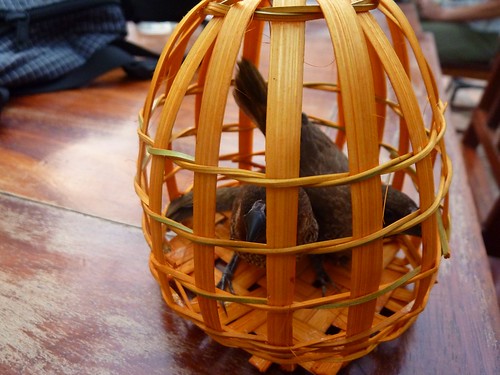 My birds. I have no idea how they get the birds into the cages. There were no doors - you just had to pull the sides apart far enough that the birds could find their way out.
My birds. I have no idea how they get the birds into the cages. There were no doors - you just had to pull the sides apart far enough that the birds could find their way out.
I think that local people take their birds to a temple to release them, but I didn’t bother with that. I just let mine go right away, making sure to get a few photos from some friendly Alaskan tourists who were sitting at the next breakfast table (with an empty bird cage next to them, so clearly they knew the drill).
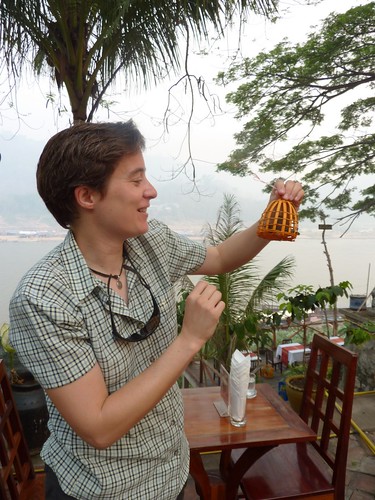 Me getting ready to release my little birdies (and my hair even looks ok!)
Me getting ready to release my little birdies (and my hair even looks ok!)
Later on I saw little boys who had gathered up the abandoned, empty cages, so I suspect there’s some recycling going on there. I think the birds may actually be recycled too – someone told me they’re trained to come back, probably because they get food from their handlers. Some of the people selling the birds were also selling fingerling-sized fish swimming around in little bags of water (of course they were in bags!). I assume you were meant to release the fish into the river. The whole thing was really interesting.
Of course Pi Mai is about more than just dousing passers-by. And of course there's actually a reason for the water-play. My understanding is that it’s about cleansing yourself and others for the New Year. When I got watered down by Lao locals in the side streets (as opposed to the crazy gangs on the main drag) you could tell they were doing it with a sense of playfulness, but also with respect and genuine good wishes. I was told that they also wash the Buddhas in the temples at this time every year and on Day Two of the festival I discovered a quiet temple just off the main street and saw evidence of this very thing. The monks had set up a long serpent-shaped downspout arrangement, and were using it to pour water over a Buddha at ground level. I’d seen these serpent thingies in other temples and always wondered what they were for, so it was very cool to see one in use.
 The little guy at the bottom was collecting the run-off water in a plastic bottle. I assume the water that has washed a Buddha on Pi Mai is very special indeed.
The little guy at the bottom was collecting the run-off water in a plastic bottle. I assume the water that has washed a Buddha on Pi Mai is very special indeed.

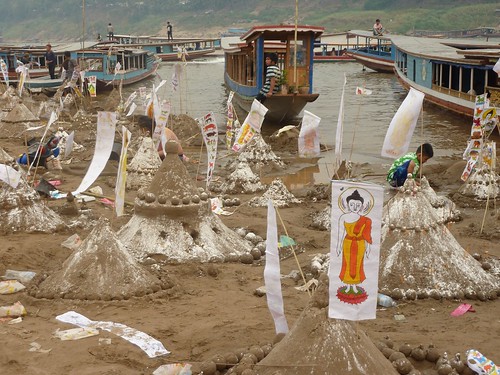


3 Comments:
That posting had 2 photos of you.
Excellent adventures.
Get well soon.
rh
Wonderful adventure, neat tradition.
Wow...I saw the first picture of the birds in the cage then the one of you holding it (it looked so tiny) and thought it had shrunk..cool perspective...
Post a Comment